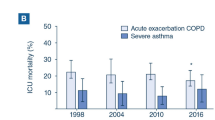Abstract
Compliance with continuous positive airway pressure (CPAP) therapy is one of the most difficult management problems for patients with obstructive sleep apnea (OSA). We postulated that autotitration positive airway pressure (APAP) may be effective in some patients who have an intolerance of fixed CPAP. The study was done to estimate how often patients who cannot tolerate fixed CPAP can tolerate APAP. We identified 25 patients seen in the Sleep Disorders Center who had been treated with fixed CPAP for OSA and were intolerant of CPAP therapy despite multiple efforts to improve tolerance. We substituted APAP therapy and measured subjective and objective compliance with treatment 1 month later. The primary end point was the number of patients who successfully tolerated the use of APAP at the end of 30 days, measured objectively by the device’s compliance monitor. A positive outcome was defined as an average use of APAP that was greater than 3 h per night on more than 70% of possible nights. Of the 25 patients (mean age, 68 years; mean apnea–hypopnea index, 35), 11 were able to tolerate APAP therapy. The mean number of hours of use in these responders was 6.2; the mean percentage of nights of use among responders was 89%. Determinants of successful APAP use were an apnea-hypopnea index (AHI) less than 18, male sex, OSA related to rapid eye movement, and a high body mass index. APAP therapy may be an effective option in patients who do not tolerate fixed-CPAP therapy.
Similar content being viewed by others
References
Young T, Palta M, Dempsey J et al (1993) The occurrence of sleep-disordered breathing among middle-aged adults. N Engl J Med 328:1230–1235
Caples SM, Gami AS, Somers VK (2005) Obstructive sleep apnea. Ann Intern Med 142:187–197
White DP (2006) Sleep apnea. Proc Am Thorac Soc 3:124–128
Farre R, Hernandez L, Montserrat JM et al (1999) Sham continuous positive airway pressure for placebo-controlled studies in sleep apnoea. Lancet 353:1154
Jenkinson C, Davies RJ, Mullins R et al (1999) Comparison of therapeutic and subtherapeutic nasal continuous positive airway pressure for obstructive sleep apnoea: a randomised prospective parallel trial. Lancet 353:2100–2105
Montserrat JM, Ferrer M, Hernandez L et al (2001) Effectiveness of CPAP treatment in daytime function in sleep apnea syndrome: a randomized controlled study with an optimized placebo. Am J Respir Crit Care Med 164:608–613
Engleman HM, Douglas NJ (2004) Sleep. 4. Sleepiness, congestive function, and quality of life in obstructive sleep apnoea/hypopnoea syndrome. Thorax 59:618–622
Doherty LS, Kiely JL, Swan V et al (2005) Long-term effects of nasal continuous positive airway pressure therapy on cardiovascular outcomes in sleep apnea syndrome. Chest 127:2076–2084
Gay P, Weaver T, Loube D et al (2006) Positive Airway Pressure Task Force, Standards of Practice Committee, American Academy of Sleep Medicine. Evaluation of positive airway pressure treatment for sleep related breathing disorders in adults. Sleep 29:381–401
Kribbs NB, Pack AI, Kline LR et al (1993) Objective measurement of patterns of nasal CPAP use by patients with obstructive sleep apnea. Am Rev Respir Dis 147:887–895
McArdle N, Devereaux G, Heidarnejad H et al (1999) Long-term use of CPAP therapy for sleep apnea/hypopnea syndrome. Am J Respir Crit Care Med 159:1108–1114
Zozula R, Rosen R (2001) Compliance with continuous positive airway pressure therapy: assessing and improving treatment outcomes. Curr Opin Pulm Med 7:391–398
Engleman HM, Wild MR (2003) Improving CPAP use by patients with the sleep apnoea/hypopnoea syndrome (SAHS). Sleep Med Rev 7:81–99
Kakkar RK, Berry RB (2007) Positive airway pressure treatment for obstructive sleep apnea. Chest 132:1057–1072
Berkani M, Lofaso F, Chouaid C et al (1998) CPAP titration by an auto-CPAP device based on snoring detection: a clinical trial and economic considerations. Eur Respir J 12:759–763
d’Ortho MP, Grillier-Lanoir V, Levy P et al (2000) Constant vs. automatic continuous positive airway pressure therapy: home evaluation. Chest 118:1010–1017
Meurice JC, Marc I, Series F (1996) Efficacy of auto-CPAP in the treatment of obstructive sleep apnea/hypopnea syndrome. Am J Respir Crit Care Med 153:794–798
Berry RB, Parish JM, Hartse KM (2002) The use of auto-titrating continuous positive airway pressure for treatment of adult obstructive sleep apnea: an American Academy of Sleep Medicine review. Sleep 25:148–173
d’Ortho MP (2004) Auto-titrating continuous positive airway pressure for treating adult patients with sleep apnea syndrome. Curr Opin Pulm Med 10:495–499
Hukins C (2004) Comparative study of autotitrating and fixed-pressure CPAP in the home: a randomized, single-blind crossover trial. Sleep 27:1512–1517
Massie CA, McArdle N, Hart RW et al (2003) Comparison between automatic and fixed positive airway pressure therapy in the home. Am J Resp Crit Care Med 167:20–23
Littner M, Hirshkowitz M, Davila D et al (2002) Standards of practice committeee of the American academy of sleep medicine. Sleep 5:143–147
Loube DI (1999) Technologic advances in the treatment of obstructive sleep apnea syndrome. Chest 116:1426–1433
Rigau J, Montserrat JM, Wohrle H et al (2006) Bench model to simulate upper airway obstruction for analyzing automatic continuous positive airway pressure devices. Chest 130:350–361
Lofaso F, Desmarais G, Leroux K et al (2006) Bench evaluation of flow limitation detection by automated continuous positive airway pressure devices. Chest 130:343–349
Nolan GM, Ryan S, O’Connor TM et al (2006) Comparison of three auto-adjusting positive pressure devices in patients with sleep apnoea. Eur Respir J 28:159–164
Weaver TE, Maislin G, Dinges DF et al (2007) Relationship between hours of CPAP use and achieving normal levels of sleepiness and daily functioning. Sleep 30:711–9
Acknowledgment
Editing, proofreading, and reference verification were provided by the Section of Scientific Publications, Mayo Clinic. This study was supported by a grant from ResMed, Poway, CA.
Author information
Authors and Affiliations
Corresponding author
Rights and permissions
About this article
Cite this article
Parish, J.M., Miller, B.W. & Hentz, J.G. Autotitration positive airway pressure therapy in patients with obstructive sleep apnea who are intolerant of fixed continuous positive airway pressure. Sleep Breath 12, 235–241 (2008). https://doi.org/10.1007/s11325-007-0158-2
Received:
Revised:
Accepted:
Published:
Issue Date:
DOI: https://doi.org/10.1007/s11325-007-0158-2




